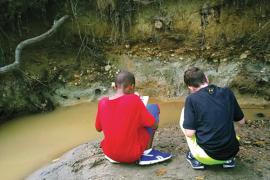As the busyness of summer gives way to a more laidback autumn, many camp professionals find themselves considering changes and adaptations to make the next camp season even better. Part of that consideration is an assessment of your camp's health services.
This concept is intentionally used because, as we've learned from the Healthy Camp Impact Report (ACA, 2011), a camp's health services are much broader than the four walls of the health center.Assessing camp health services is driven by three factors: 1. The health needs of campers and staff; 2. The camp's decision as to how much responsibility the camp retains for meeting health needs; and 3. Injury-illness incident data from the previous year (Erceg and Pravda, 2005). For example, a day camp that draws campers from the immediate area and that has ready access to parents will have a different scope of health services than a month-long residential program with campers from across the world who go on tripping programs to remote areas.
Health Needs of Campers and Staff
Each camp seeks to enroll campers and hire staff who complement the camp's program and philosophy. With that in mind, consider the health needs of your camp's target clientele and make a determination about your ability to meet those needs. For example, a common need is access to health supports beyond those provided by the camp. This is easy to accomplish for many day camps, but residential camps host campers and staff who are away from their provider networks. While some supports can be provided at camp, what access is there beyond camp for needs such as mental-emotion health, dental and orthodontia, pharmacy, chiropractic services, and, for some, allied health practitioners (e.g., Christian Science practitioner, acupuncture, herbal therapy)? Communicate the scope of available services to prospective campers and staff so expectations are appropriate to what is available.
Another common health need is for an organized, efficient camp system that complements the growth and development needs of both campers and staff. Since the age range of campers and staff can be quite broad, meeting the developmental needs for that span can be tricky. It's why one places more counselors with younger campers than with older kids. It's the reason why opportunities for personal choice are built into the program. Meeting developmental needs is even reflected in menu development, bed times, and the types of camp activities available to a given age range. So consider the developmental needs of the camp population and how the camp experience complements or frustrates those needs. Seek to minimize the frustration points while preserving the strategies that meet the needs.
A third example of a health need is access to competent providers when health problems emerge. This drives decisions such as who staffs the health center and what their competencies are. It colors what credentials are held by tripping staff and the training given to cabin staff regarding campers' personal health (personal cleanliness, appropriate clothing, adequate rest, etc).
Many camps also identify the need for a monitored environment that minimizes the risk of communicable disease and is supported by risk management policies to reduce/eliminate identified hazards. Interestingly, meeting this need also addresses a basic emotional need: the need for personal safety. By providing a robust risk reduction program, one frees the energy of campers and staff to thoroughly engage with camp rather than focus on maintaining their personal safety. It's also the reason why safety procedures are rehearsed, why child protection practices are deep, and opening day's health screening is done.
The key point is that a thorough grasp of camper and staff health needs allows one to determine if camp health systems adequately address these needs. Having a plan that addresses health needs keeps campers and staff engaged with the growth elements of camp. It also provides marketing points when a parent asks, "How safe will my child be at your camp?"
Functional Elements of Camp Health Services
In addition to assessing the camp's ability to meet the health needs, also consider the functional elements of camp health services. There are three functional areas:
- The provision of healthcare at camp: The primary responsibility for this is typically vested with the camp's health center staff. They are the caregivers. However, the scope of their services is usually determined by camp administration (see "Oversight" function below).
- The camp's emergency response system: This team of people, often led by the camp director, is responsible for coordinating and delivering service to campers and staff when emergencies arise. This team also includes a person who functions as a liaison should external fire, police, or ambulance personnel become involved.
- Oversight of camp health services: This functional role is often the responsibility of the camp director or a healthcare professional who works an expanded contract (duties beyond care-giving). The focus of this role is to coordinate and oversee the camp's health services; consequently, this individual typically intersects with a variety of people, which includes camp personnel, external direct care providers, and emergency services personnel.
When reviewing the effectiveness of these functional roles, consider the communication that must be in place for them to be effective. And then consider the problems that arose in the past year surrounding health services. Often these problems surface because of inadequate communication. For example, a nurse in the health center may feel quite capable of doing allergy injections because "I do them all the time at my clinic job." However, the person overseeing health services may have placed that service outside the scope of care provided at camp for any number of reasons (e.g., no M.D. at camp; no capability to start an I.V. at camp; camp insurance sets practice boundaries). If the camp nurse — the designated provider — is not told about the boundaries of his/her camp practice by the individual responsible for oversight, the nurse may inadvertently cause tension that could have been avoided. So review last summer's tension points surrounding healthcare and ask how improved communication might minimize — if not eliminate — the potential for future problems.
To assist this process, give a copy of a primary responsibility grid (see Table 1) to people who are part of your camp's health services team. Several health-related tasks are listed. Ask your informants to place a check in the column of the role that holds primary responsibility for each task. Compare results. Points of diversion indicate trouble spots and the need to talk through that point to eliminate confusion.
Review the Year's Injury-Illness Data
Finally, review incidents from the past year. Sort injury-illness data into two groups: campers and staff. What is the information telling you? Ask a series of questions, such as:
- What were the top three reasons for people going to see a doctor? Might something be done to minimize those potentials?
- When a communicable illness was identified, how many other people also got ill? What might be changed to limit this potential?
- Is there any activity at which injury tends to happen? If so, why? What might be changed?
- Is there a particular context in which injury or illness occurs? What might be changed to improve this?
- Is there a difference between what happens to boys and girls? Campers and staff?
- How much work time did staff loose because of injury and illness? What might be done so they spend more time on the job?
- Compare the year's data with previous years; notice any trends?
- What role did fatigue play in injury-illness events? Did staff and campers stay well-rested as the camp season progressed?
When doing this data review, remember to include data from parent evaluations, phone calls, and evaluative comments from staff. These sources often provide insight that's lost if not intentionally reviewed.
Finally, pull your information together and assess your satisfaction level. Targets for improvement will certainly be present, but also determine your overall satisfaction about your camp's health services. There will be some pleasant surprises! Then plan your desired changes and implement that plan. Don't let autumn's window of opportunity go by without making those changes.
References
American Camp Association. (2011). The healthy camp impact report. Martinsville, IN: American Camp Association.
Erceg, L.E., & Pravda, M. (2005). The basics of camp nursing. Monterey, CA: Healthy Learning.
Linda Ebner Erceg, R.N., M.S., P.H.N., is the associate director of Health & Risk Management for Concordia Language Villages and executive director of the Association of Camp Nurses in Bemidji, Minnesota.


